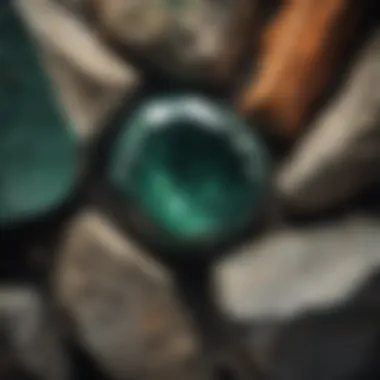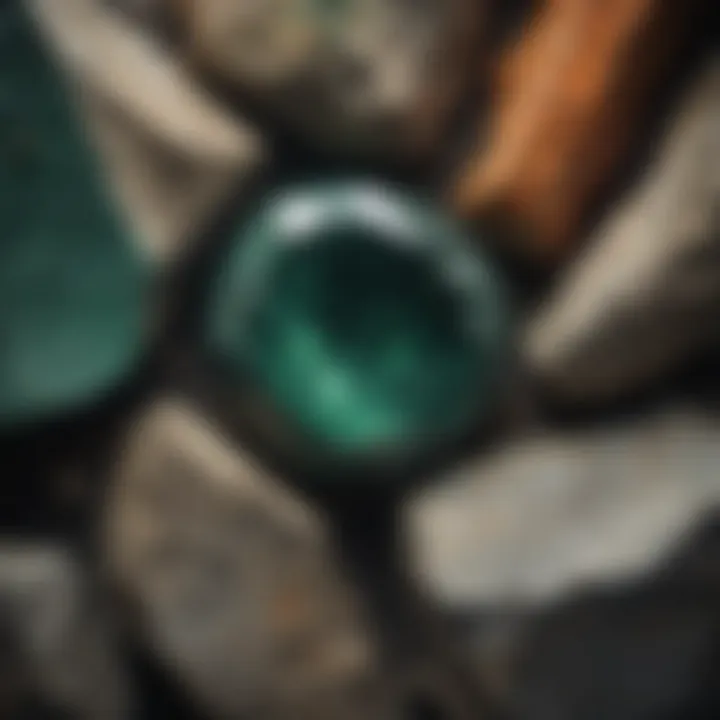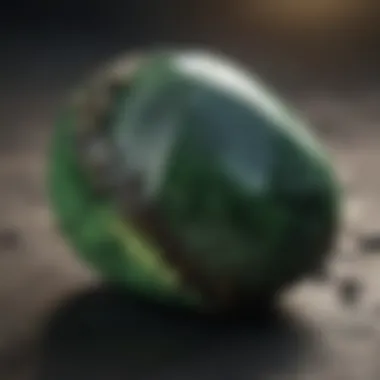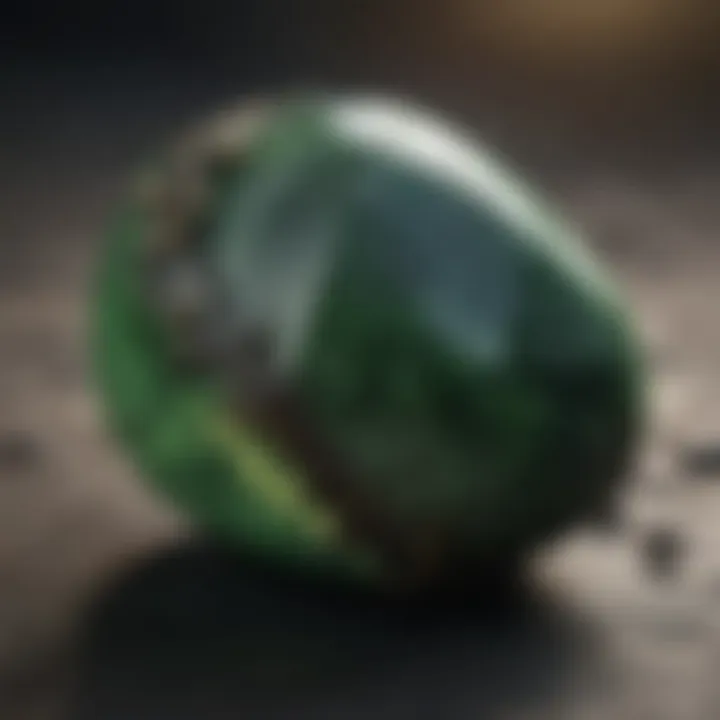Exploring the Depths of Green Stone with Black Lines


Intro
Green stone featuring striking black lines is not just an ordinary find; it carries a story deep within its very structure. This intricate gemstone grabs attention with its vivid colors and unique patterns, drawing the interest of gemstone enthusiasts, collectors, and professionals alike. As we embark on this exploration, we’ll uncover various types of gemstones exhibiting these fascinating color combinations, alongside the intricate geological processes that lead to their formation.
Moreover, the rich cultural symbolism attached to these stones unveils their significance across different societies. And let's not forget the allure of the metaphysical properties attributed to various stones, touching on beliefs and values that have transcended generations. Whether you're a novice or a seasoned collector, the journey into understanding these unique stones promises to be fulfilling, shedding light on care tips, identification guidance, and valuation insights. Moreover, we'll touch on the current market trends affecting these green stone treasures.
Gemstone Overview
Definition and Characteristics
Green stones with black lines are often recognized for their distinct visual appeal, created due to the inclusion of various minerals during the stone's growth process. These stones can range from a deep forest green to a more vibrant shade, often flecked with sharp black streaks or lines. Some might even call them nature's artwork, as each piece is uniquely crafted by geological events over millennia.
The characteristics of these gemstones can vary widely; some may be opaque while others have a translucent quality. Commonly found varieties include jade, malachite, and certain types of agate. The interplay of colors often showcases a blend of strength and tranquility, making them highly sought after for both jewelry and decorative purposes.
Classification of Gemstones
Classifying gemstones is no small task, as they can be grouped in several ways based on their physical and chemical properties. In the realm of green stones with black lines, one might categorize them based on their mineral composition. For example:
- Jadeite: A part of the jade family, known for its rich green hues and cultural significance in many Asian societies.
- Malachite: Recognizable by its layered appearance and striking green tones, commonly used in carvings and jewelry.
- Agate: A variety of chalcedony, often displaying a banded appearance that can include green and black shades.
Each of these gemstones brings unique attributes that can appeal to different preferences and purposes.
Historical Significance
Ancient Uses and Cultural Importance
Historically, green stones with black lines have held a place of prominence among various civilizations. In ancient China, jade was revered as a symbol of purity and moral integrity. It wasn't merely a stone but a status symbol that enhanced its wearer's prestige. Similarly, malachite has been utilized since antiquity not only in jewelry but also as a pigment for art, known for its vivid green color.
Cultural narratives surrounding these stones often intertwine with spiritual beliefs. In many societies, they were considered talismans, believed to confer protection or enhance the wearer's connection to nature.
Myths and Legends Surrounding Gemstones
As with many gemstones, an aura of myth and legend often surrounds green stones with black lines. Tales told through generations speak of jade as a guardian against misfortune, or malachite being a stone of transformation, rumored to attract wealth and fortune. Some believed that holding or wearing these stones during significant life transitions would bestow wisdom or clarity, enhancing the individual’s journey.
Understanding these narratives adds layers to the appreciation of these stones, making them more than just geological specimens but also carriers of rich cultural heritage.
"Gemstones have a life and meaning of their own that can connect deeply with humankind, transcending mere aesthetics."
By taking a deeper dive into these formations, one can better comprehend the allure of green stone dotted with black lines, revealing a rich tapestry of both geological and cultural significance.
Prelude to Green Stones with Black Lines
Understanding green stones featuring black lines is crucial for anyone who appreciates the beauty and complexities of gemstones. These stones often exhibit unique patterns which spark curiosity and admiration. The varied shades of green intertwined with stark black lines create a visual contrast that captivates the eye. This article aims to elucidate the significance of these stones, emphasizing their fascinating qualities and rich histories.
Defining Green Stone with Black Lines
Green stones with black lines are not just a feast for the eyes; they encompass a range of gemstones that display a characteristic green hue punctuated by dark streaks or veins. This distinct look can be attributed to various minerals within the stone. For example, the interplay of iron and other trace elements often influences the color and pattern. Understanding the science behind these formations can enhance appreciation for their beauty.
Green stones can be categorized into different types based on their mineral composition. For instance, serpentine features a mix of green and black that recalls the colors of nature, while malachite incorporates shades of deep green with striking black patterns that resemble brush strokes. Each type possesses its own unique allure and story, inviting deeper exploration.
Historical Overview
The history of green stones with black lines traces back thousands of years, weaving through various cultures and civilizations. In ancient times, these gemstones were often revered for their perceived mystical attributes. The Egyptians, for instance, cherished malachite, using it for cosmetics and amulets. They believed it protected the wearer from evil forces. As cultures evolved, so did the perceptions surrounding these stones.
In other regions, particularly in Asia, green stones with black lines found their place in religious and spiritual practices. They were not just decorative objects but symbols of wealth and power—a tangible connection to the divine. Furthermore, as trade routes expanded, the allure of these stones crossed borders, leading to their integration into various cultural artifacts.
As one delves deeper into the story of green stones featuring black lines, a tapestry of meaning comes to light. These stones hold not only aesthetic value but also historical significance, reflecting the beliefs and values of past societies. Understanding this history can enrich one’s appreciation of the gemstones, allowing for a richer narrative as one interacts with these captivating natural treasures.
Geological Origins
Understanding the geological origins of green stones with black lines provides invaluable insights into their formation, structural characteristics, and ultimately their appeal to gemstone enthusiasts and collectors alike. These stones, often admired for their unique aesthetic qualities, carry with them the history of the Earth itself, whisking us back to the very processes that shaped them over millennia. This section sheds light on how this knowledge complements our exploration of these intriguing gemstones, allowing us to appreciate not just their beauty but also the mechanisms that brought them forth.
Formation Processes
The formation of green stones with black lines involves a complex interplay of minerals and environmental conditions. Generally, these stones are the product of metamorphism, where pre-existing rocks undergo transformations due to exposure to high temperature and pressure.


- Metasomatism plays a major role here. In this process, a rock’s chemistry may change completely, driven by fluids that permeate the rock and carry other minerals into it. This is how the green coloration often appears alongside striking black veins or lines, creating the fascinating visual contrasts seen in stones like serpentine and malachite.
- Another crucial aspect is igneous activity, particularly where molten rock cools and solidifies. This may occur beneath the surface or during volcanic eruptions, as seen with certain forms of green opal where the minerals crystallize in specific patterns.
- The age and authenticity of a green stone can often tell a fascinating story about the conditions under which it formed, much like a page torn from a geological diary. The unique characteristics of each stone reveal insights into the ecological and environmental conditions from billions of years ago.
Common Locations and Sources
When it comes to specific locations where green stones with black lines can be found, several regions of the world are well-known for their deposits. Each area often reflects unique geological histories that contribute to the stones’ properties. Here are a few noteworthy sources:
- Serpentine is commonly found in regions such as California, USA, and certain parts of Canada. Intriguingly, the presence of this mineral often indicates underlying ultramafic rocks that have been altered over time.
- Malachite, a stone revered for its vivid green hues and striking banding, frequently occurs in copper-rich deposits, particularly in Africa, with notable sections from the Democratic Republic of the Congo.
- Green Opal emerges from volcanic regions and can be found in locations like Australia and Brazil, where it has formed in a myriad of striking patterns during the solidification of volcanic ash.
It's important to note that the specific conditions—ranging from mineral composition to environmental factors—play a significant role in the appearance and quality of these gemstones.
By exploring these geological origins, collectors gain a more profound understanding of what lies behind the stones they admire, adding an extra layer of appreciation for their beauty and significance.
Types of Green Stones Featuring Black Lines
When it comes to green stones that display distinctive black lines, the variety offers not just aesthetic appeal but also significant meaning and history. Each type of stone tells a story, connecting us to the geological processes that formed them and the cultures that value them. This section unravels a few notable gemstones, illustrating not only their unique characteristics but also their relevance in the worlds of jewelry making, geology, and metaphysical practices.
Serpentine
Serpentine is a captivating green stone often characterized by its richly varied hues, typically ranging from vibrant apple green to deeper olive tones, occasionally adorned with striking black lines or mottled patterns. This stone isn’t just eye candy; it has quite a history.
In ancient times, Serpentine was believed to harbor protective qualities, thought to safeguard its wearer from harm. Many cultures used serpentine as a talisman or amulet. It features prominently in artworks and carvings, thus bridging the gap between nature and artistry.
Moreover, its soft texture makes it an excellent choice for jewelry, including statement pieces and delicate settings. Whether in the form of necklaces or bracelets, serpetine is sought after by collectors and designers alike.
Serpentine is known for its ability to stimulate the heart chakra, encouraging emotional healing and balance.
Malachite
Next on this lush list is Malachite, a true marvel of nature with its deep green background often marked by swirling black veins. This stone's rich, vivid color scheme is not mere happenstance—its beauty is rooted in its copper content, which plays a significant role in imparting that lush hue.
Traditionally favored by the ancient Egyptians, who used it in jewelry and dusted on the skin as makeup, Malachite carries a weight of historical significance. In contemporary practices, this stone is cherished not only for its stunning visuals but also for its purported powers in transformation. It’s often called a stone of transformation, facilitating change and renewal.
Jewelry designers have taken a liking to Malachite, creating unique and meaningful pieces that often tell a story beyond just decoration. It serves as an expressive medium that speaks volumes to those who understand its depth.
Green Opal
Lastly, we encounter Green Opal, which, despite its unique appearance, is sometimes overlooked. Often found sprinkled with darker lines and specks, this stone's appeal lies in its mesmerizing play of color. Ranging from pale greens to deeper teal shades, Green Opal has a soft translucency that can seem almost ethereal.
Unlike other gemstones, Green Opal’s metaphysical properties invite introspection and self-reflection, providing clarity of thought. Native cultures believe it connects individuals to their inner selves while enhancing creativity, making it particularly popular among artists and writers.
As an addition to the gemstone market, it rarely steals the limelight, yet its growing presence suggests a lovley emerging demand among collectors and artisans.
In summary, these unique varieties of green stones with black lines each carry their own stories—about their formation, their historical relevance, and their place in our modern world. Whether it's the protective qualities of Serpentine, the transformative essence of Malachite, or the introspective nature of Green Opal, each has carved its niche in the vast realm of gemstones.
Cultural Significance
The cultural significance of green stones with black lines extends far beyond their aesthetic appeal. These stones have woven themselves into the fabric of various cultures throughout the ages, often embodying concepts that are deeply symbolic and meaningful. Their unique visual characteristics make them not only attractive for ornamentation but also valuable in conveying beliefs and spiritual messages. As communities and individuals seek to connect with natural elements, these stones stand out by representing both beauty and profound understanding of human existence and aspirations.
Symbolism in Various Cultures
Green stones adorned with striking black lines are viewed through different lenses across cultures. In many Indigenous communities, these stones are considered sacred and are often linked to nature’s balance. For instance, in some Native American traditions, the intertwining colors symbolize the duality of life – such as the harmony between the earth and the sky or the connection between physical and spiritual realms.
- In parts of Asia, particularly in Chinese culture, colors are imbued with meanings. Green symbolizes growth and renewal, while black often represents protection. Together in these stones, they are believed to incur a sense of security and rejuvenation to the wearer.
- In African cultures, stones similar to these may link to the concept of ancestors. They are sometimes used in rituals aiming at connecting with the past, symbolizing the grounding of one's identity and affirming the individual's place in their lineage.
In these contexts, the various interpretations enhance the allure of these gemstones. Individuals often select these stones not just for their visual appeal, but to strengthen personal identities and spiritual connections.
Use in Jewelry and Ornaments
Jewelry made from green stones with black lines serves not only as adornments but also as expressions of cultural identity and personal meaning. Artisans blend traditional craftsmanship with modern aesthetics, making unique pieces that speak to both heritage and contemporary fashion.
- Healing Amulets: Many cultures fashion these stones into charms or amulets that are believed to provide protection and healing. For example, a native craftsman might carve these stones into talismans meant to ward off ill fortune.
- Fashion Statements: Today, these stones are also found in high-end jewelry collections. Designers often highlight their remarkable patterns, producing elegant pieces like pendants, rings, and earrings that resonate with gemstone enthusiasts.
Furthermore, the contrast between the rich green and the stark black lines creates an enchanting visual dynamic that appeals to both collectors and those merely pursuing something unique for personal use. The versatility of these stones allows them to transcend simple decoration, embodying stories, cultures, and personal affinities.
"Jewelry is a way of keeping memories alive, and stones with rich histories tell the stories of countless generations."
By understanding the cultural significance of these remarkable stones, individuals can appreciate their value beyond the material. Wearing or gifting them links each person back to narratives rich with ritual, belief, and identity.


Metaphysical Properties
The exploration of metaphysical properties opens a window into the mysteries that surround green stones featuring black lines. For many, these gemstones transcend mere aesthetics, serving as powerful conduits for energy, healing, and spiritual guidance. As we delve into this domain, it becomes clear how the attributes associated with these stones resonate with enthusiasts, collectors, and even those seeking a deeper understanding of their own journeys.
Healing Attributes
Green stones adorned with black lines are often believed to carry unique healing attributes. Serpentine, for instance, is frequently cited for its ability to aid in emotional healing and personal transformation. Many gem-lovers claim that holding serpentine can help relieve stress and anxiety, acting as a stabilizing force in tumultuous times. The green color symbolizes growth, while the black lines are seen as channels for releasing negative energy, making it an ideal companion for individuals working through emotional upheaval.
On the physical level, stones like malachite are reputed to absorb pollutants and negative energies. It has been suggested that these stones may assist in cleansing the environment of toxic influences, whether internal or external. For those interested in holistic practices, including meditation and mindfulness, incorporating these stones into one's routine can elevate the experience, foster a sense of balance, and enhance emotional clarity.
Moreover, engaging with green stones can lead to physical benefits. Practitioners often place them on specific body parts to support healing practices, as each stone is considered to resonate with different chakras and energies. This practice might help enhance one's overall well-being, creating a symbiotic relationship between the individual and the stone.
"Every stone speaks a language that can be felt, if only one is willing to listen."
Spiritual Significance
Green stones with black lines also hold profound spiritual significance. They are often linked to nature and the earth’s energies. Green Opal, for example, is celebrated for its ability to stimulate an individual's creative flow and deep inner reflection. Many artisans and jewelry designers incorporate these stones into their work, believing them to act as sources of inspiration and grounding.
Spiritually, these gemstones are thought to open pathways to intuition and self-discovery. Their unique color patterns symbolize a connection to the dualities of life—the balance of light and dark, growth and decay. This duality can provide insight into one's own struggles and motivations, making them valuable companions on the journey of self-exploration.
Additionally, stones like green tourmaline have been associated with prosperity and abundance, believed to attract positive energies into one’s life. Collectors and enthusiasts often include this stone in their spiritual practices, hoping to harness its reputed ability to foster prosperity and supportive relationships. Engaging with these stones can encourage users to embrace their true self, nurturing a deeper understanding of their own spiritual journey.
Overall, the metaphysical properties of green stones with black lines offer a compelling synthesis of healing and spiritual growth. Understanding and harnessing these attributes allows individuals to cultivate a more enriched existence, both personally and spiritually.
Identifying Green Stones with Black Lines
Identifying green stones with black lines holds great significance for both collectors and enthusiasts. In a world where countless gemstones exist, distinguishing these unique stones is crucial for appropriate valuation, usage, and appreciation. Recognizing their distinctive features allows jewelers, designers, and hobbyists to harness their beauty in ways that honor their inherent properties. Knowing how to identify these stones not only prevents misidentification but also enhances the overall experience of owning and working with them.
Furthermore, such knowledge fosters a deeper appreciation for the geological journeys these stones have undergone, granting insight into their origins and significance.
Key Identification Features
To effectively identify green stones with black lines, several key features come into play. These characteristics not only help in differentiating between similar-looking stones but also provide a framework for understanding their authenticity:
- Color Variation: The green hues can vary widely, ranging from deep forest green to more vibrant emerald tones. The black lines often create a stunning contrast that enhances the overall appearance.
- Patterning: Each stone presents a unique pattern of black lines, which can be wavy, straight, or intricate, resembling natural landscapes or artistic streaks.
- Texture: Some stones in this category can be smooth and polished, while others might have a more rough, natural surface texture.
- Hardness: Assessing hardness is essential, as it allows one to differentiate between actual gemstones and softer minerals that may resemble them.
- Translucence: Holding the stone up to the light reveals its translucence or opacity, giving further clues to its identity.
"An eye for detail is essential; sometimes, it's the minutiae that tell the truest story of a gem."
Common Misidentifications
While the beauty of green stones with black lines can be captivating, it's easy to confuse them with other minerals. Here are some common misidentifications to be cautious of:
- Black Tourmaline: Often mistaken for certain green stones, black tourmaline has a much more crystalline structure and lacks those characteristic green hues.
- Jade: The green variations in jade, especially jadeite, can mimic the look of green stones with black lines. However, jade tends to have a more uniform texture without the striking patterning.
- Chrysoprase: This stone can also feature green colors sometimes, but it usually lacks the prominent black striations and possesses a much different luster.
- Serpentine: While serpentine is one of the green stones mentioned earlier, its visual cues can easily lead to misidentification if one is not attentive to the finer details and characteristics.
Cultivating the ability to identify green stones with black lines not only enriches one’s collection but also deepens appreciation for the diversity within the mineral world. This underscores the importance of ongoing education and exploration in this fascinating field.
Care and Maintenance
Taking good care of your green stones with black lines is crucial, especially if you want to preserve their unique beauty and extend their lifespan in your collection or as part of your jewelry. Just like a car needs regular tune-ups or a fine wine needs the right storage, these gemstones have their own maintenance demands that shouldn’t be overlooked. Proper care keeps them looking their best while also ensuring that their inherent value is maintained.
Cleaning Techniques
Cleaning green stones properly can be a delicate task, but doing it right doesn’t have to be rocket science. Start by gently dusting with a soft cloth, ensuring you remove any surface dirt. For a more thorough clean, you can mix a mild soap with lukewarm water.
- Steps for Safe Cleaning:
- Prepare Your Solution: Use a few drops of liquid soap in lukewarm water.
- Soak and Wipe: Soak a soft cloth in the mixture, gently wiping the stone. Avoid soaking the stone directly to prevent damage.
- Rinse: Wipe it down with a clean damp cloth to remove soap residue.
- Dry Thoroughly: Always air dry or use a soft towel.
Avoid harsh chemicals or abrasive materials since these can scratch or dull the surface. Remember, might not seem like much, but even little residues can affect how light reflects off them, dulling their shine.
Storage Recommendations
When it comes to storing your green stones, think of it like arranging a library – you want to keep everything organized and protected. Proper storage is key to avoiding scratches and damage that could happen if a stone comes in contact with harder surfaces or items.
- Recommended Practices:
- Use Soft Pouches: Soft fabric pouches can help minimize scratches. Each stone should ideally have its own compartment.
- Avoid Direct Sunlight: Keep them away from direct sunlight, as prolonged exposure can fade their vibrancy.
- Maintain Humidity: Store them in a moisture-controlled environment to avoid warping or cracking.


Your stones will thank you for providing them a cozy spot when not on display or in your jewelry box.
"A little care can go a long way in preserving the beauty and integrity of your beloved gemstones."
By following these simple yet effective care and maintenance strategies, you not only ensure the longevity of your green stones with black lines but also keep them dazzling, enhancing their overall charm.
Value Assessment
Understanding the value of green stones with black lines is a crucial aspect for both collectors and jewelry designers. These unique gemstones not only possess aesthetic appeal but also hold significance that can influence their worth in the market. When assessing the value, several key elements come into play which can dictate pricing, rarity, and desirability.
Factors Influencing Value
- Rarity: The availability of a particular type of green stone with black lines can greatly affect its market value. For instance, high-quality malachite with distinct patterns is often more sought after than more common varieties.
- Quality and Clarity: Stones that showcase vivid color saturation and clear, well-defined black lines tend to fetch higher prices. Clarity is another critical factor; inclusions or imperfections can detract significantly from a stone's value.
- Size and Carat Weight: Larger stones generally command higher prices, though this is subject to the aforementioned quality measures. A 10-carat stone that is clear and well-formed will certainly be valued more than a 2-carat stone with noticeable flaws.
- Provenance: A gemstone's history can impact its value. Stones that come from renowned sources or have a unique story can attract higher interest. The narrative behind a stone may resonate with collectors, enhancing its appeal.
- Market Trends: Changes in consumer interest, fashion, and gemstone investment opportunities can also play a role in determining value. Keeping an eye on trends could assist potential buyers in making informed decisions.
Market Demand Insights
The demand for green stones with black lines is continually evolving. Recent years have seen a surge in interest driven by both aesthetic appreciation and metaphysical beliefs. The way these stones are marketed can influence public perception and ultimately their prices.
“Market forecasts suggest a growing trend among millennials and Gen Z collectors, who seek unique, sustainable gemstones.”
- Emerging Markets: As more people explore the fields of crystal healing and mindfulness, the demand for green stones, particularly those valued for their healing properties, has increased.
- Fashion Industry Influence: Celebrities and influencers showcasing jewelry made from these gemstones can spike demand significantly. The visibility of such stones in high-profile settings tends to elevate interest and perceived value.
- Online Platforms: With a rise in e-commerce, buyers have more access to gemstones than ever before. Marketplaces such as eBay and Etsy allow enthusiasts to find unique pieces, while social media platforms help to educate and nurture communities around these stones, further driving interest.
Market Trends
Understanding the market trends pertaining to green stones with black lines is pivotal for both collectors and traders alike. Such knowledge aids enthusiasts in navigating a landscape that is ever-evolving, influenced by consumer preferences, emerging scientific findings, and global economic shifts. The gemstone market can be a tricky beast to wrangle, but armed with the right insights, one can make educated decisions that enhance not just personal collections, but also investment portfolios.
In particular, the growing interest in sustainable and ethically sourced gemstones has influenced market dynamics. Consumers today are more discerning, preferring stones that come with a clear provenance and align with eco-friendly practices. This shift in consumer behavior underlines the importance of transparency and authenticity in the market, paving the path for green stones, especially those with unique appearances, to gain traction.
Emerging Trends in the Gemstone Market
As we step into a new era, several key trends are materializing in the gemstone market, painting an exciting future for green stones with black lines. Here are some noteworthy developments:
- Sustainability at the Forefront: There's a clear escalation in the demand for responsibly sourced stones. Buyers are leaning towards companies that ensure minimal environmental impact, spotlighting the need for ethical mining practices.
- Online Marketplaces: E-commerce is shaking things up, allowing collectors access to a wider range of options from around the globe. The ease of online trading platforms is making it simpler than ever to buy and sell unique stones.
- Customized Jewelry: The trend of personalized and bespoke jewelry is on the rise, with more individuals looking to express uniqueness through their gemstones. Green stones, given their distinct appearance, fit beautifully into this trend.
"In a world increasingly focused on sustainability, green stones with black lines are becoming symbols of not just beauty but also ethical responsibility."
These trends reflect a broader cultural shift, where aesthetics alone don’t cut it; there’s a demand for meaning and intention behind every purchase.
Investment Potential
Investing in green stones with black lines can provide lucrative opportunities, especially as the market evolves. Various factors contribute to potential investment success:
- Rarity and Demand: Some green stones, particularly those with striking black inclusions, are relatively rare. As demand escalates for unique and visually striking specimens, so does their value.
- Market Resilience: The gemstone market often demonstrates resilience even in turbulent economic times. With green stones symbolizing not just beauty but also sustainability, their appeal is likely to endure.
- Long-Term Appreciation: Just like fine art, exceptional gemstones can appreciate over time. Securing high-quality pieces now might translate into significant returns in the future.
To make the most out of investments in green stones, one should stay informed about market trends, while also prioritizing education on the specific stones being considered. This ensures informed decision-making that can avert common pitfalls in gemstone investment.
Ending
In wrapping up the exploration surrounding green stones with black lines, it's crucial to understand the multifaceted nature of this unique gemstone. The discussion throughout this article has highlighted key aspects such as geological formation, cultural significance, and the diverse types of stones one might encounter, allowing readers to appreciate not just their beauty but also their story.
The importance of understanding these stones goes beyond mere aesthetics. Awareness of their various types, like serpentine and malachite, equips collectors and enthusiasts with knowledge indispensable for informed choices in purchasing and collection practices. Furthermore, comprehending the cultural symbolism associated with these stones can deepen one’s connection to their heritage or the lore attached to them.
Benefits of Delving into This Topic:
- Awareness of Authenticity: A well-informed collector can better differentiate genuine gems from imitations, avoiding pitfalls that sometimes accompany the marketplace.
- Connection to Nature: Recognizing the geological origins of these stones enhances one’s appreciation for the natural world, bridging the gap between the earth’s processes and the beauty crafted over millennia.
- Investment Insight: Understanding market trends prepares individuals for financial decisions related to gemstone investments, ensuring both personal fulfillment and financial prudence.
Thus, the conclusion encapsulates valuable insights and considerations, encouraging a continuation of exploration beyond the pages of this article.
Recap of Key Points
To summarize, we’ve identified several core elements regarding green stones with black lines:
- The geological processes involved in their formation.
- Various types such as serpentine, malachite, and green opal, each with unique characteristics and properties.
- Cultural significance that grants these stones a narrative beyond their physical appearance.
- Metaphysical properties enhancing their allure for many collectors and enthusiasts.
- Insightful identification tips for differentiating genuine stones, alongside care instructions ensuring longevity.
- Market dynamics influencing the value and desirability of these gems.
This concise encapsulation underscores that green stones with black lines are indeed more than mere decorative elements; they are rich in history and meaning.
Encouragement for Further Exploration
The pursuit of knowledge about green stones with black lines should not conclude here. The world of gemstones is vast and endlessly fascinating. For enthusiasts, collectors, or even casual admirers, many resources illustrate the depth of this topic.
Consider seeking out local gem and mineral shows where you can engage directly with collectors and geologists, allowing for practical insights and perhaps even hands-on experiences with these captivating stones. Online platforms such as /r/gemstones on Reddit provide a community where passionate individuals share their discoveries, collecting tips, and experiences.
Curiosity can also be satiated through further reading. Websites like Britannica and Wikipedia offer extensive background on the earth sciences behind gemstones, while targeted literature on gemstone identification and care can pave your path toward mastery in the field.







